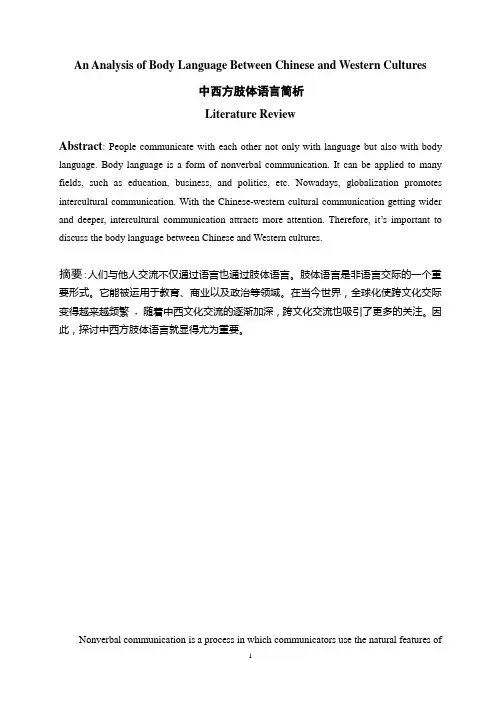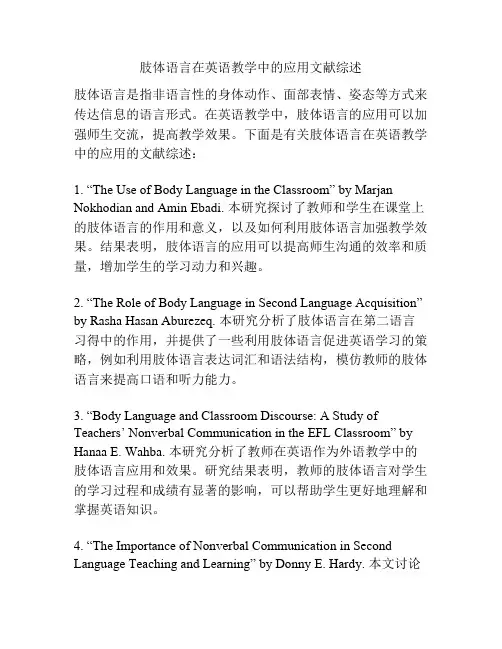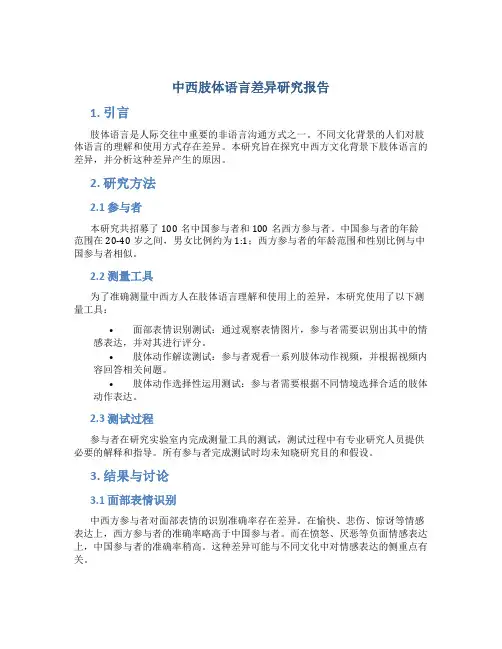中外肢体语言参考文献
- 格式:docx
- 大小:12.59 KB
- 文档页数:1

开题报告英语东西方肢体语言的差异一、论文选题的背景、意义(所选课题的历史背景、国内外研究现状和发展趋势)历史背景:哲学家和科学家已经连接人与意义的物理行为,情绪和人格年为数以千计,但只有在人们的记忆中有详细的身体语言研究的成熟,成为今天这样。
第一个已知的语言方面的专家很有可能是古希腊人,特别是希波克拉底和亚里士多德,通过他们的通信权益人的个性和行为,罗马人特别是西塞罗,有关情感和手势。
身体语言的分离在最近出现的时候,例如1605年培根地位的学习,口语交流探讨手势作为反射或延伸。
查尔斯达尔文在十九世纪后期可以被为最早的专家了,但肢体语言研究的观察,似乎都没有实质性的发展,至少在未来一百五十年。
现状和发展方向:今天我们所知道的流行和可获得的肢体语言的研究是非常近的。
1972年,朱利叶斯.快速写道:“身势【肢体语言】依然作为一门新的学科,…”朱利叶斯是美国快速行为作家获奖小说和非小说作品的处理,特别是与人类生理的影响。
他的书里的肢体语言是是首先将这里主题进行了研究。
弗洛伊德和精神分析在其他的领域-19世纪中后期和20世纪初-将有很好的个人空间认识的许多方面,身体语言,但他们并没有集中在非语言沟通的概念或理论发展的肢体语言在他们的权利。
对身体语言研究的不同观念与人类的行为有关,这很强烈的体现在德斯蒙德.莫里斯的书里《裸猿》(1967)和《亲密行为》(1971)。
虽然他的理论没有集中在肢体语言上,但是莫里斯在后60年代和70年代对为什么我们思考,发出行为和沟通有不可磨灭的意义。
二、研究的基本内容与拟解决的主要问题本篇文章主要通过对比分析来论述东西方肢体语言的差异同而促使大家对英语国家的深入了解。
文章的第一部分是引言,导入了肢体语言等的定义及文章的写作目的。
第二部分是论述东西方肢体语言的差异,其中通过相同的肢体语言有不同的意思和不用的肢体语言有相同的意思并且结合具体例子来表达。
而第三部分着重论述搞成肢体语言差异的原因,其中通过对这些国家的文化,宗教,和生活方式的比较同时结合例子来完成。

An Analysis of Body Language Between Chinese and Western Cultures中西方肢体语言简析Literature ReviewAbstract: People communicate with each other not only with language but also with body language. Body language is a form of nonverbal communication. It can be applied to many fields, such as education, business, and politics, etc. Nowadays, globalization promotes intercultural communication. With the Chinese-western cultural communication getting wider and deeper, intercultural communication attracts more attention. Therefore, it’s important to discuss the body language between Chinese and Western cultures.摘要:人们与他人交流不仅通过语言也通过肢体语言。
肢体语言是非语言交际的一个重要形式。
它能被运用于教育、商业以及政治等领域。
在当今世界,全球化使跨文化交际变得越来越频繁,随着中西文化交流的逐渐加深,跨文化交流也吸引了更多的关注。
因此,探讨中西方肢体语言就显得尤为重要。
Nonverbal communication is a process in which communicators use the natural features oftheir bodies to express specific meaning instinctively to the other communicator. Body language, as a form of nonverbal communication, plays a very important role in communication. Some scholars even considered it as the basis of nonverbal communication.In general, the study of body language began in 1950s. And during 1970s, the study of body language stepped into a fully developing period. From the late 1970s to the early 1980s, body language includs more contents and has a great influence on the other fields. In current intercultural communication, the most accepted means to classify body language is by the movement of human body. “Body language” is used by Samovar, who classifies body language into appearance, body movement, facial expression, eye management, touching, sub-language, olfactic behavior, and so on.Meanwhile, the classification made by Knapp is that body language contains gesture, body movement, extremities movement, hand movement, facial expression, eye management, posture, and so on. Brosnahan thinks “gestures”are touching, space, appearance posture, body behavior, arm movement, leg movement, hand movement, facial expression, eye management, noisy and silent decorations, the environment, and so on. Hu Wenzhong thinks body language has the definition in both narrow and broad senses. In the broad sense, it contains gesture, posture, facial expression, timbre of the speaker, distance between the speaker and listener, and clothes of the speaker. As to the narrow sense, it includes body movement and facial expression, which can send messages. From all these ways of classification, we can know that body language mainly includes the movement of every part of a human body, instead of the limits to the body movement.Recently, there has been huge interest in studying human behavioral clues that could be useful for developing an interactive and adaptive human-machine system. Unintentional human gestures have been found conveying some useful information in specific context. Some researchers have tried to extract such gestures in a specific context of educational applications.In Guo Pingli’s The Use of Body Language in English Teaching, she discussed the possibility and effect of using body language in English teaching. For rapid changes in education reform, many teachers, students and parents face great stresses. As we know, the classroom teaching is one of the most important ways that the students learn English. Body language is a way to arouse students’ interest and help them learn better. In school education, body language plays a positive role in cultivating students’characters. As a matter of fact, teachers’ friendly appearance can greatly encourage students’ enthusiasm. Besides, knowledge also requires the vivid and accessible gestures to make it figurative. English teaching is a keypart of the school education. According to students’ present level, body language is required. Students play an active role in teaching. Their excellent competences come from daily practice. Therefore, teachers should improve students’ competence and create the learning atmosphere with body language.Body language is the most common and universal nonverbal behaviors. Because of different gender cultures, body language has different meanings and communication varies from people to people. In On Body Language in Nonverbal Communication from the Perspective of Gender Culture by Yang Chenxia, despite the definition of body language, the author also gave us the gender differences in body language. Gender is known as the social classification of masculine and feminine. So gender is a social creation. In gender cultures, men and women in general have different perspectives on these matters. The difference in feminine and masculine styles frequently leads to misunderstandings in cross-gender interaction. It is said that women have the tendency to resort to nonverbal expressions more frequently. Scholars also found out that men use more gestures than women, and men do not discriminate. Smiling is a specific facial expression. People attribute many positive characteristics to others who smile. Compared with men, women smile more, are more apt to returning smiles, and more attracted to others who smile. These indicate that consciously or unconsciously, women just use smile as a responder of politeness, or just to keep the interaction flowing smoothly. Research shows that females smile more often than males. The studies related to eye contact show that women look more at the other person than men do. Moreover, women hold eye contact longer with each other than men do. Many studies seem to show females are touched by others more than males are. It seems that women value touching more than men do. Body language changes when it comes to gender culture. We should learn the differences of body language in different gender.Human beings are not the only ones who communicate. Animals use body language and facial expressions to tell each other how they feel and what they think. Some scholars find the origin of body language. The relation of body language to animal communication has been discussed. Human paralanguage may represent a continuation of forms of communication that our non-linguistic ancestors already used, or it may be that it has been changed by co-existing with language. Some species of animals are especially adept at detecting human body language, both voluntarily and involuntarily. Body language is a product of both genetic and environmental influences. The ethologist Irenaus Eibl-Eibesfeldt claimed that a number ofbasic elements of body language were universal across cultures and must be fixed action patterns under instinctive control. Some forms of human body language show continuities with communicative gestures of other apes. More refined gestures, which vary between cultures, must be learned or modified through learning, usually by unconscious observation of the environment.Body language is now widely used in the field of selling, where sales personnel are trained to observe and read the body language of their potential customers. Sales personnel trained to read body language can now utilize this skill to read the subliminal cue exhibited by the customers to close a deal. Consequently, many companies such as insurance companies, direct-selling companies, and international car-showrooms now engage body language experts.Body language is shaped by culture. Different cultures make people behave different body languages. And every culture has its unique historical background.In Wang Sha’s On Body Language Differences from Intercultural View, she explains in details about the body language in different countries from the intercultural view, especially about posture differences, gesture differences, facial expression differences and eye contact differences. Body language is a term for communication using body movements or gestures instead of verbal language. It includes the most delicate movement of eyebrows. Moreover, body language can combine the use of facial expressions. A psychologist proposed a formula: the total impact of message=7% verbal + 38% vocal + 55% facial expressions and behavior. There are some characteristics of body language. First, some body language is not inborn but also unconscious and subconscious. However, other body languages are postnatal. Second, the same body language conveys different meanings due to different cultures. Third, the same body language represents same meaning in different cultures. Fourth, some body language behaviors may have different meanings in the same culture. Sixth, the using of body language is influenced by the situation where a person is.Body language is necessary in the communicating activity. China plays a vital role in the whole world, therefore it is critical for us to learn intercultural communication. With the Chinese-western cultural communication getting wider and deeper, intercultural communication attracts more attention. In my view, we shall pay more attention to the differences of body language between Chinese and Western cultures. From these scholars’classifications, we can conclude that body language mainly includes the movement of the parts of a human body, not just limits to the body movement. In this essay, the eye language, posture,gesture, touch and facial expression in Chinese and Western cultures are to be studied. Chinese people are more modest, tolerant, and responsible. However, people from western countries advocate independence, freedom, individual space and self-respect. Eye contact is important because too little eye contact causes communication problems. It is crucial in relationships because it helps to show intimacy, attention and influence. In some cultures, looking people in the eye is assumed to indicate honesty and straightforwardness; in others it is seen as challenging and rude. All cultures have their special rules about their eye language and these differences can make people feel uncomfortable without knowing the reason. Posture is a matter of how people sit, walk, stand and move. Posture can deliver everyone’s hidden information no matter how hard he tries to cover his feelings. Gesture is another kind of body language. Touch is the means by which people communicate via bodily contact. It also plays a vital role in nonverbal communication and conveys physical intimacy. Communication is a central part of everyday life. Human beings exchange information not only with words but also with facial expressions. Although different cultures shape different body languages, there are still some similarities. Body language varies from culture to culture. Conflicts and differences are inevitable in the intercultural communication. Therefore, it is necessary to use the body language to make communications better and easier.BibliographyBirdwhistell, Ray. Kinesis in Context. Philadelphia: University of Pennsylvania Press,1970. Jones, Yarbrough. A Naturalistic Study of the Meaning of Touch. California: Communication Monographs, 1985.Kendon, Adam. Gesture: Visible Action as Utterance. Cambridge: Cambridge University Press, 2004.Leathers, Dale. Successful Nonverbal Communication. Boston: Alyyn&Bacon, 1986郭萍利. The Use of Body Language in English Teaching. 北京:科学教育家,2008(2).胡文仲.文化与交际.北京:外语教学与研究出版社,1994.杨晨霞. 从性别文化的角度研究非语言交际中体态语. 北京:商品与质量,2010,(11).王莎. On Body Language Differences from Intercultural View. 山东:科技信息, 2009(2).。


【关键字】学校中国某某某某学校学生毕业设计(论文)题目:跨文化交流中的肢体语言姓名:00000班级、学号:系(部) :经济管理系专业:商务英语指导教师:开题时间:完成时间:31 日目录课题跨文化交流中的肢体语言一、课题(论文)提纲三、参照文献Body language in intercultural communication0000摘要:肢体语言是文化交流的一部分。
肢体语言,众所周知,是指能够传递某种特定信息的面部表情、手势语,以及其他身体部位动作。
像动作,脸部表情,眼神交流等等。
用肢体语言来表达感情几乎是人类的本能。
因为它简单方便,所以被广泛的运用于生活中。
除一些世界公认的肢体语言外,不同的文化还有各自的肢体语言。
在进行跨文化交流时,相同的肢体语言形式可能具有完全不同的意义。
本文比较了不同文化的肢体语言的差别并简单阐述了肢体语言,以便于我们更好的提升沟通技巧和理解能力。
AbstractBody language is a part of intercultural communication. Body language, as is universally known, means elements in nonverbal communication produced by body. Such as movement, facial expressions, eye contact and so on. Use body language to express emotion almostly is a instincts of human itself. It is widely used in reality life Because of its simple、fast、directly. except some admittedly body languages, different cultures have different body languages. When you process an intercultural communication, the same body language form probably shows different meaning. This article intends to compare the difference of body language with different culture,present its meaning and talk it briefly so that we can improve our communication skills and abilities by understanding it wellKeywords:body language;interculturcommunication;applicationIntroduction:Intercultural communication , means the interaction between people from different background.In nowadays, economy globlization trends becoming obvious day by day, intercultural communication is no longer a rare thing to us. With the fast development and popularity of the internet,it is very convenient for people to carry on intercultural communication. A basic content of intercultural communication is body communication, if the message can not handle well, misunderstanding will caused in intercultural communication sometimes. Therefore, when you carry on intercultural communication, you should understand some common body language in international communication.The necessity and importance of language in intercultural communicationBody language plays a significant role which complete language in intercultural communication. Why do language have such a essential effects on communication?Because sometimes, body language be able to express meaning or contents more profound than verbal language,they can express what the verbal language cannot express directly.People communicate with each other by their body language in the ways of nodding, waving, eye contact, shrugging and so on. Use body language to express emotion almostly is ainstincts of human itself. It is widely used in dai ly life Because it i s simple,fast,directly.Like all of other nonverbal communication behaviors, body language serves a variety of purposes. Body language sometime repeats or takes place of verbal communication with the use of gestures. Moreover, body language can regulate social interaction, and finally it conveys our attitude toward ourselves and toward others in communication. In addition, it express information masterly and leave a better imagine space on others.As an unique way of communication, body language plays an irreplaceable role in people's munication is mainly depend on verbal language or written word, but as a matter of fact, body language is regard as a widely method to express emotion, attitude or advice. And have affect on communication deeply.According to the relevant statistics, the percentage of body language communication is about 65% in social occasion. A psychologist give up a formula:Transmit of information= 7%language+38%voice+55%body languageAlthough the aboved data need a further discussion, while it is more emphasis on the role of body language in interpersonal communication. Non-verbal action, majority is unconsciously reveal, and it often reflects his real feelings. It is more easier for people to disguise words when using language, In the process of communication, meanwhile, the non-verbal behavior is not so easy to conceal. As Freud said “understanding people's deep psychological idea, language is not reliable, the body languages are more true than human’s emotion and desires.”In the process of information communication, not only the expression and movement appears with the disseminator’s verbal language, but also the recipients are receiving information while showing a series of expressions. It is an important feedback, it is a recipient psychological feedback, it is more important than the language.2.The classification of body language2.1Facial expression languageExpression refers to the person's facial expressions. How many people's facial expressions it is, I’m afraid it is impossible to work out, there are some common facial expressions like:"happiness, anger, sadness and joy, others such as fear, disappointment,it is called as changing. No wonder Roman Rolland said, “facial expressions is the language which nurturedcenturies and thousands of times more complex than the mouth talking. ”The eyes are the windows of the soul, eye contact is the main source of confidence in nonverbal communication. Besides, we convey ideas by eyes,the eyebrow and mouth movements also can not be ignored.2.2 Hand languageThe use of hand and arm movements, is the most powerful method to convey his ideas in body language.In a general sense, we have to use hand gestures to help strengthen the ideas or describe things. Therefore, it is used everywhere. Even in a social situation. Gesture language is the most important part of the body language, is the most important silent language, is the most useful language. No matter the past, now and the future, its still an indispensable tool of people contacts. In the different nationality or ethnic groups, the meaning of same kind of sign language expression may be roughly the same or similar, also may be quite the opposite. The following are several common sign language:V-gesture: It has become Esperanto for long time, and it is come from the because the V word in English on behalf of Victory, so V express the joy and sense of victory to people. When you use this gesture, you need turn your finger’s back to your face. It is said that this gesture become popular after the British Prime Minister Winston Churchill use during the Second World War in English-speaking countries. Be careful when using this gesture, you must put palm out, otherwise, means stigma, neglect to other.OK gesture: There is no doubt that it is also a Esperanto which composed of english letters O and K, its means no problem, everything is ready , also shows i’m fine, all right, thank you for your attention.However, in the south of , OK gesture means that something he disapproved is not worth mentioning.In the Middle East and , this gesture symbolizes holes, which have a clear meaning of homosexuality. If in the bar and other public places, someone show you this gesture is probably looking for a partner, and do not return a thumb gestures, you also do not think he told you OK,so you are politely return a ok.In addition, leg movements can also reveal personal potential consciousness.At a meeting, a staff suddenly received a call from his wife who said that her mother had acar accident and went to the hospital, asked him to the hospital immediately. After the call, of course, he was very anxious and want to ask for leave. But at that time, his manager is giving a speech and hate to be interrupted. If his action left a bad impression on the manager, it will directly affect his promotion prospects. He was quitely worried, but can not take any action, so he frequently look at the door, and also turn his toes towards the door. At this moment, the manager just find his movement and ask the reason, then let him leave immediately.2.3 Poseture languageBody language includes human’s standing posture, walking posture and sit, squat, stoop, sleep and so on.Psychologists have pointed out that a man’s legs are close together when he standing,it generally make a stable and reliable impression on people, and it will also left a difficult communication impression ;while a man stand with his legs apart, his legs have a little toe out of people, then it gives a bold, aggressive proactive attitude to people;A mans legs close together, one after another, which reflects he has ambitious targets, haste temper but very brave and full of adventurous spirit; There is also a kind of person, when he stand focus on one foot, the other foots toes touch the ground behind gravity legs, these people would mostly like to change, willing to face challenge. Of course, standing posture not entirely representative of a person, because well-trained professionals could change body posture, but it at least can make it clear that standing posture is an important language, it has the ability to convey his ideas.Person's walking posture can express a variety of feelings, such as pleasure,frustration,passion, or lazy, slack and so on. psychologists found that: the person whose pace is large and elastic, their hands swinging force, are usually more self-confident, optimistic, objectives; walking pace inertia and variable of the speed ,that kind of person are more hesitant, pessimistic, insight view; People who like to dominate others usually like walk a high kick backwards ;When a women walking , the higher her arm swing, the more t she is energetic; On the contrary, women who walked less by arm swinging, most of them are in the thoughts confusion or frustration.What the“ real” secret of the Body Language exhibited is that all verbal languages can not cover. In the process of intercultural communication, especially those regarding the interests and rights of negotiation, consultation, communication. experienced people who able to master“secretBody language”, often through analyse other's instantaneous exposed body movements or posture, grasp each other's mood swings, real inner intentions quickly.and thereby get the initiative and advantage position. So familiar with “Secret Body Language”as important as English proficiency, even more important.2.The factors influence body language in intercultural communication .Because of different nationalities in which the ecological, physical, social and religious environment is different, each language environment have given rise to a different language habits, socio-cultural, folklore and customs of various contextual factors, and therefore in different cultures, the meaning of body language is not exactly the same, all ethnic groups of communication have different non-discursive way.The probable reasons that cause these diofference are as follow:3.1Different sense of valueIt should be recognized that the values of Eastern and Western cultures have lot of difference, due to the acceleration of world economic globlization process, the international cultural exchanges and cooperation become more frequent.The cultural mutual penetration of different levels in different countries and regions is more obvious, but some deep-rooted values of each are unique. For example, the United States as the representative of Western culture, in terms of value mainly showed as utility, efficiency, emphasize individualism and privacy, have a strong sense of competition and adventure spirit.Besides, westerners havent thoughts of hierarchy, humble, and expensive, cheapdistinction.Of course, many Westerners, is also have double standard in the values. Such as privacy, some U.S. companies prevail to steal employee's privacy, the company let security person look up the file folders, notebooks, open the phone calls, browsing phone automatically record card, or even open the computer, copy file on hard drive when the employees are go outside.Therefore, in the process of intercultural communication, both sides want to achieve understanding and respect, we must first understand and respect each other's values.3.2 Different customsIn the human experience and belief, custom play the dominant role, therefore, there is an old saying“when you in rome, do as romans do”.And if we Chinese people visit others,the host usually offer tea or drinks for guest, the guests will repeatedly refuse and say “no”, or “don't bother”even if the guest is very thirsty, extremely desire to drink tea. While most of the foreigners, often require host if they can offer something to drink, or the host ask guests what would they like to drink, guests is very delight to tell the host what to drink. And there are lot of things sounds like a joke, but that is the true. A Chinese meet his foreign friends outside,then he askl “Mr, have you eaten”? Then, say goodbye to the foreigner, m ove forward .H owever,the foreigners think Chinese friend treat him a dinner today. Another thing, but also because of the customs of the gap, and raises the below jokes.A foreigner visit his Chinese friend’s home, according western manners, foreign friends praised host “Your wife is beautiful” According to Chinese custom, the host hurriedly reply “where , where”? foreign friends think the host ask him which party is beautiful ? He added “everywhere”.3.3 Language hibitsChinese people usually tend to explain the reason fisrt, and then get down to the business, on the other way around, westerners, such as Americans answer the phone, introduce themselves first“this is xx company, can I help you?” when the Other party explain clearly whom he want speak to ,then ask: may I know who is this ? But we often “hey, who is this? Or who do you speak to”?4 . Understand and use body language correctlyA Chinese man talks to an American or Canadian woman, is it impolite to look at each other?In various cultural background , whether nod head means “yes”, shock head means “no”?4.1 Correctly understand different meaning of different body languageIt is necessary to understand that body languages have different meaning in the same situation, and the same body language have diffrent meaning in the diffrent occasion.It is important to note that body language has different meanings in different cultures. How to interpret body language, it depends on the situation, the culture, the relationship we have with the person as well as the gender of the other. This means that there is not one signal that has the same meaning all over the world. Body language is also interlinked with spoken language and a whole pattern of behaviour from a person. As well as that, various body language signs can help each other to understand meaning clearly or strengthen the meaning of what we express.For example, shaking head at sometimes does not absolutely means disapproval, also it is possible means “unbelievable” or “do nothing” or even a think highly of praise --- “fantastic”. For example, when you see a football player shoot a ball into the goal, you probably will shake you heads to praise. Similarly, in the process of interaction, we must correctly identify the meaning of each other’s same sortof action, which is very important.Due to body language behavior is often comparatively obscure, you have to identify each other's true colors through this hazy “veil”, without a certain social experience and sometimes its not really easy to distinguish. For example you ask someone to help, the other can say “OK” or “no” to you, but some people often can not express in his face resolutely “do it or not”, it is a subtle meaning.4.2 Understand the meaning of others’eye contacts correctlyIt is necessary to understand the meaning of each other's eyes, but also learn how to use eye contact to communicate.A personal eye expression plays an important role in interpersonal communication. The eye contact foremost serve as enhancing human interaction, For speakers, its better for them to control, regulate themselves. Warning , points out other's role so that they could adjust their conversation or manner timely. For listening people, different eye contacts can tell other whether you listen or not, or absent-minded. You can also look at each others to encourage them to go on, indicate others end the conversation.The way of using eyes contact is different in differentcountries and communities. Westerners, Americans, the Israelis, when they are talking to someone, their eye contacts is relatively strong, so both sides take the measure that they through the information launch of eyes contacts, enhancing the penetration power of the audio language. Asians, their eye contact are more softer,and they would not look others intently as westerners. But generally speaking, when you are talking with others, the scope of eye contacts activities should be natural circulate at each other's eyes, head, shoulder, take soft spots policy.4.3 Correct application of gesture and posture languageIn social occasions, or when dealing with people, we need to learn how to correctly use gestures and posture to convey your feelings and hopes to each others, at the same time, you should understand other's gestures and posture message.In the cultural exchanges, there are lots of common sign languages.A mans hands twisted tightly, it shows that he is nervous; rubbing his hands that shows he is eager; his hands spread out, that means there is no reservation; cover his mouth with hand, shows surprise.And then, due to different cultural backgrounds, the same gesture would have a totally different meaning, for example,the American put the palm inside means peace or victory, but in the United Kingdom it might convey the opposite message. ConclusionBody language is a important method of human communication,its connotation is also different with the difference of cultural inviroment, life style,thinking habbits. Therefore, in cross-cultural communication, we should learn and understand the meaning of body language in different countries and regions, by using it properly to reduce conflict, improve communication quality, only the two sides will master a variety of body language communication forms of different meanings, place them in the appropriate cultural context so that achieve communicative purposes.参考文献:[1]许静.非语言交际的跨文化差异与外语教学[A].上海外语出版社,2005[2]顾曰国.跨文化交际[M].北京:外语教学与研究出版社,1997.[3]贾雨新.跨文化交际[M].上海:上海外语出版社,1997[4]毕继万.跨文化非语言交际[M]. 北京:外语教学与研究出版社,2001此文档是由网络收集并进行重新排版整理.word可编辑版本!。

肢体语言在英语教学中的应用文献综述肢体语言是指非语言性的身体动作、面部表情、姿态等方式来传达信息的语言形式。
在英语教学中,肢体语言的应用可以加强师生交流,提高教学效果。
下面是有关肢体语言在英语教学中的应用的文献综述:1. “The Use of Body Language in the Classroom” by Marjan Nokhodian and Amin Ebadi. 本研究探讨了教师和学生在课堂上的肢体语言的作用和意义,以及如何利用肢体语言加强教学效果。
结果表明,肢体语言的应用可以提高师生沟通的效率和质量,增加学生的学习动力和兴趣。
2. “The Role of Body Language in Second Language Acquisition” by Rasha Hasan Aburezeq. 本研究分析了肢体语言在第二语言习得中的作用,并提供了一些利用肢体语言促进英语学习的策略,例如利用肢体语言表达词汇和语法结构,模仿教师的肢体语言来提高口语和听力能力。
3. “Body Language and Classroom Discourse: A Study of Teachers’ Nonverbal Communication in the EFL Classroom” by Hanaa E. Wahba. 本研究分析了教师在英语作为外语教学中的肢体语言应用和效果。
研究结果表明,教师的肢体语言对学生的学习过程和成绩有显著的影响,可以帮助学生更好地理解和掌握英语知识。
4. “The Importance of Nonverbal Communicatio n in Second Language Teaching and Learning” by Donny E. Hardy. 本文讨论了肢体语言在第二语言教学中的重要性,以及教师如何利用肢体语言来促进学生的语言学习。
研究结果表明,肢体语言是促进学生语言学习的重要工具,教师应该注重肢体语言的应用和培养。

中西肢体语言差异研究报告1. 引言肢体语言是人际交往中重要的非语言沟通方式之一。
不同文化背景的人们对肢体语言的理解和使用方式存在差异。
本研究旨在探究中西方文化背景下肢体语言的差异,并分析这种差异产生的原因。
2. 研究方法2.1 参与者本研究共招募了100名中国参与者和100名西方参与者。
中国参与者的年龄范围在20-40岁之间,男女比例约为1:1;西方参与者的年龄范围和性别比例与中国参与者相似。
2.2 测量工具为了准确测量中西方人在肢体语言理解和使用上的差异,本研究使用了以下测量工具:•面部表情识别测试:通过观察表情图片,参与者需要识别出其中的情感表达,并对其进行评分。
•肢体动作解读测试:参与者观看一系列肢体动作视频,并根据视频内容回答相关问题。
•肢体动作选择性运用测试:参与者需要根据不同情境选择合适的肢体动作表达。
2.3 测试过程参与者在研究实验室内完成测量工具的测试,测试过程中有专业研究人员提供必要的解释和指导。
所有参与者完成测试时均未知晓研究目的和假设。
3. 结果与讨论3.1 面部表情识别中西方参与者对面部表情的识别准确率存在差异。
在愉快、悲伤、惊讶等情感表达上,西方参与者的准确率略高于中国参与者。
而在愤怒、厌恶等负面情感表达上,中国参与者的准确率稍高。
这种差异可能与不同文化中对情感表达的侧重点有关。
3.2 肢体动作解读中西方参与者对肢体动作的解读也存在差异。
在示意性动作,如招手、点头等方面,中西方参与者的解读准确率相近;而在非示意性动作,如手势配合说话等方面,西方参与者的准确率较高。
这可能是因为西方文化中肢体语言在日常交流中更为频繁使用,使得西方人对非示意性动作更加敏感。
3.3 肢体动作选择性运用通过肢体动作选择性运用测试,我们发现中西方参与者在不同情境下选择肢体动作的偏好不同。
中国参与者更倾向于使用身体接触类动作,如拥抱、握手等,以表达亲近和友善;而西方参与者更倾向于使用空间类动作,如指向、挥手等,以表达引导和指示。

从中西方肢体语言看文化差异(根据调查研究:当我们在与他人进行沟通时,语言只是起到7%的传达的作用。
语气却占去剩下的38%。
更重要的是:肢体语言在沟通中起到了55%的影响。
(相对于沟通的内容和环境)那么,什么是肢体语言?肢体语言(body language)是指能够传递某种特定信息的面部表情、手势语,以及其他身体部位的动作等等。
它在人际交往过程中起着非常重要的作用。
由于社会的发展,国与国之间的交流不断加强,西方的许多肢体语言在我国也已经被认同,还有一些被普遍适用。
比如:西方人往往指胸口来表示“我”。
大拇指朝上,表示“好”;但大拇指朝下则表示“坏,糟透了”。
还有用大拇指指尖与食指指尖相接成O形,伸直其余三个指头,表示OK,即“正常”、“顺利”、“没问题”。
伸出食指和中指成V形,表示victory(胜利)。
如果招手示意别人过来,他们是伸出手,掌心朝上,捏拢四指,前后弯动食指。
当然,在中国和西方国家中,肢体语言其含义也存在不同程度上的差异。
不过,很多肢体语言表达的含义还是一致的,比如,点头表示:同意或者表示明白了,听懂了;眉毛上扬表示:不相信或惊讶;避免目光接触意味着:冷漠,逃避,不关心,没有安全感,消极,恐惧或紧张等;摇头表示:不同意;鼓掌:赞成或高兴等等,但是在这里,我们主要通过分类来说明,在不同的文化背景下,不同的肢体语言在不同程度上所存在的差异,了解从中体现出来的文化差异,从而提高我们学习语言的兴趣。
一、动作一样,意义不同(the same action,different meaning)。
如下例:1. 跺脚(stamp one’s foot):在中国人看来,表示气愤,恼怒,灰心,悔恨。
比如说:气得直跺脚。
而它的英文含义则是不耐烦,比如:give a stamp of impatience(不耐烦得跺脚)。
2. 目不转睛地看(look with fixed gaze):其中文含义是:好奇;有时是惊讶。

中西文化中肢体语言差异分析摘要:肢体语言是一种重要的非语言交流手段。
在日常交流中,特别是在跨文化交流中,肢体语言起着极其重要的作用。
在跨文化交际中,我们往往只重视语言交际,而忽视了非语言交际,特别是肢体语言的重要性。
在跨文化交流中打破障碍的最有效方法是掌握肢体语言的含义。
肢体语言之间有相似之处,但有些肢体语言在不同文化中的含义并不完全相同。
因此,了解中国和西方国家肢体语言的差异是很重要的。
关键词:肢体语言;跨文化交流;传递信息;文化差异在西方,“肢体”一词被引入各个领域,成为一些哲学家、社会学家、语言学家、心理学家和其他学者的研究对象。
许多中外学者对“肢体语言”的起源有不同的看法,有人认为肢体语言起源于先天的遗传;有人认为肢体语言来自于人类后天的经验;还有人认为肢体语言是一种自然能力。
[1]一、文献综述在中国,受语言学研究氛围的影响,20世纪80年代以前,教育领域的研究者很少考虑肢体语言在教育教学中的作用。
20世纪80年代以来,我国学者逐渐认识到肢体语言在教育教学中的作用,并在引进国外著作的基础上开展了对教师肢体语言的研究。
20世纪80年代,《外国教材》、《外国中小学教育》等刊物上发表的一系列译文引发了中国学者对教师肢体语言研究的关注。
20世纪90年代初,《教育评论》、《教育科学》等权威刊物发表了一些学者对教师肢体语言的初步探索文章,代表了此后人们研究的趋势。
此后,学者们或在《教学的艺术》等作品中专设章节论述教师肢体语言,或以专著的形式系统论述教师肢体语言,如《教师体态语的艺术》。
肢体语言出现在语言诞生之前,根据进化论的分析,人类在诞生之初就用肢体语言进行交流。
然而,近几十年来,一些美国社会心理学家和人类学家开始科学系统地分析肢体语言的构成,人们开始关注肢体语言学。
事实上,对肢体语言学的研究早在20世纪就开始了。
1644年,博沃出版了《手势的研究:手的自然语言》,该书被学者们认为是最早的肢体语言专著。

肢体语言的中西方文化差异第一篇:肢体语言的中西方文化差异肢体语言的中西方文化差异尼泊尔人、斯里兰卡人和有些印地安人和爱斯基摩人用点头表示“不”。
因此,要用外语进行有效的交际,在说某种语言时就得了解说话人的手势、动作、举止等所表示的意思。
我们可以观察一下阿拉伯人同英国人谈话。
阿拉伯人按照自己的民族习惯认为站得近些表示友好。
英国人按照英国的习惯会往后退,因为他认为保持适当的距离才合适。
阿拉伯人往前挪,英国人往后退。
谈话结束时,两个人离原来站的地方可能相当远!在这个例子里,双方的距离是关键。
不同的民族在谈话时,对双方保持多大距离才合适有不同的看法。
根据研究,据说在美国进行社交或公务谈话时,有四种距离表示四种不同情况:关系亲密,私人交往,一般社交,公共场合。
交谈双方关系亲密,那么身体的距离从直接接触到相距约45厘米之间,这种距离适于双方关系最为亲密的场合,比如说夫妻关系。
朋友、熟人或亲戚之间个人交谈一般以相距45~80米为宜。
在进行一股社交活动时,交谈双方相距1.30米至3米;在工作或办事时,在大型社交聚会上,交谈者一般保持1.30米至 2米的距离。
在公共场合,交谈者之间相距更远,如在公共场所演说,教师在堂上讲课,他们同听众距离很远。
多数讲英语的人不喜欢人们离得太近,当然,离得太远也有些别扭。
离得太近会使人感到不舒服,除非另有原因,如表示喜爱或鼓励对方与自己亲近等,但这是另一回事。
记住这一点很重要。
在英语国家里,一般的朋友和熟人之间交谈时,避免身体任何部位与对方接触。
即使仅仅触摸一下也可能引起不良的反应。
如果一方无意触摸对方一下,他(她)一般会说Sorry;Oh,I’m sorry;Excuse me等表示“对不起”的道歉话。
在中国,常常听到西方妇女抱怨中国人抚弄了她们的婴儿和很小的孩子。
不论是摸摸、拍拍、接接或是亲亲孩子,都使那些西方的母亲感到别扭。
她们知道这种动作毫无恶意,只是表示亲近和爱抚而已,所以也不好公开表示不满。

国际政治家的肢体语言及其深层含义探讨论文政治家是指那些在长期的政治实践中涌现出来的具有一定政治远见和政治才干、掌握着政党或国家的两道权力并对社会历史发展起着重大影响作用的领导人物。
以下是店铺今天为大家精心准备的:国际政治家的肢体语言及其深层含义探相关讨论文。
内容仅供参考,欢迎阅读!国际政治家的肢体语言及其深层含义探讨全文如下:引言人类社会的交往是靠信息的传递得以实现的。
一般来说,这种传递可分为语言和非语言两种形式。
成功的交际不仅要理解语言行为,而且要理解非语言行为。
肢体语言是人类交际中最常见的一种非语言行为,它包括眼神、手势、身姿、面部表情和体触等,它同语言行为相辅相成,共同完成交际过程,实现交际的最终目的。
同样,在政治场合中,如果你想要辨别政治人物所说话的真伪,很大程度上不是听他说什么,而是观察他的行为。
如果仔细研究一下那些政治舞台上的风云人物,你便可以从他们的肢体语言解读出那些隐藏在他们无声肢体语言背后的真正含义。
本文旨在通过对肢体语言的解读,揭开隐藏在肢体语言背后的深层含义,从一种新的角度去理解大国间的交际关系。
一、文献综述(一)国外研究关于肢体语言,国外早在1644年就有一个叫约翰·布尔沃的做过一些研究。
他出版的《手势研究:手部的自然语言》,被视为肢体语言研究的开创性着作。
1790年,朱利叶斯·法斯特《体态语言》的问世,使得人们注意到肢体语言的重要性,并从此打开了人们研究肢体语言的大门。
查尔斯·达尔文于1872年出版的《人类和动物的情感表达》一书,是20世纪以前最有影响力的一部作品。
虽然这是一部以讲述理论为主的作品,适于学者阅读,并不适合大众阅读,但是,这本书却引发了一场全球范围内的关于面部表情与肢体语言的现代研究,达尔文的许多观点和观察结果最终也都得到了来自世界各地的研究者们的证实。
从那时起直至现在,研究者们已经收集并记录下了将近一百万条非语言信息及线索。

国内外肢体语言研究最新文献肢体语言是指通过头、眼、颈、手、肘、臂、身、胯、足等人体部位的协调活动来传达人物的思想,形象地借以表情达意的一种沟通方式。
一、肢体语言论文参考文献[1]谢慧娟,曹霞。
跨文化交际中肢体语言浅析[J]. 今古文创,2021,(36):113-114.[2]张童涵。
肢体语言在声乐舞台表演中的作用[J]. 戏剧之家,2021,(24):66-67.[3]董佳鑫。
戏剧导演创作中肢体语言运用探析[J]. 戏剧之家,2021,(23):24-25.[4]吕传彬。
职场中人必修之肢体语言[J]. 秘书之友,2021,(08):46-47.[5]隋爽彪。
肢体语言在话剧表演中的有效运用实践[J]. 参花(上),2021,(08):115-116.[6]沈美光。
肢体语言在声乐演唱中的应用探讨[J]. 大众文艺,2021,(14):101-102.[7]王盛。
肢体语言在小班语言教学中的应用[J]. 清风,2021,(14):79.[8]董昭红。
用好肢体语言,让管理更轻松[J]. 教育家,2021,(28):66.[9]于滋舜。
浅析戏剧表演中肢体语言的表演技巧[J]. 剧作家,2021,(04):118.[10]张帆。
肢体语言在数字虚拟影像创作中的运用[J]. 现代电影技术,2021,(07):37-40.[11]李艺漫。
微探肢体语言在影视表演中的重要性[J]. 艺术大观,2021,(20):93-94.[12]万亚文。
肢体语言在大学英语教学中的作用探析[J]. 校园英语,2021,(27):31-32.[13]李美静。
论演员肢体语言对舞蹈作品"意境"的营造[D].中央民族大学,2021.[14]李凯。
民间锣鼓表演中肢体语言的功能[J]. 剧影月报,2021,(03):56-57.[15]王洋。
声乐演唱中肢体语言的重要性及表达方式的研究[J]. 喜剧世界(下半月),2021,(06):87-88.[16]张琦。
论文:从肢体语言看中西方文化差异Chinese and western cultural differences in body language一.引言二.肢体语言概述(一)肢体语言的概念及特征(二)肢体语言的相关理论三、肢体语言在差异文化中的发展与演变(一)肢体语言在人类社会交流方面的重要性1 不同种类的肢体语言所代表的意思2 肢体语言在交流中的作用以及重要性3 在中西方交流中,怎样恰当的使用肢体语言?(二)社群交流及族群认同性对区域文化历史的形成、发展的重大影响1中西方区域文化的历史的形成和发展对比2 中西方区域交流文化的重大差异(三)区域文化对肢体语言的反作用(四)中西方文化的主要内容和差异1 肢体语言对中西方交流文化的影响2 通过肢体语言对中西方交流文化造成差异的过程以及原因3 中西方交流文化中的肢体语言的比较以及异同四.肢体语言的东西方差异,在经济全球化带动文化交流融合的现代的发展趋势。
1 在中西方交流中学习肢体语言的必要性和重要性2 肢体语言在文化交流中的发展趋势五.结论1 General ideas of body languageA the definition of body languageB the relative theory of body language2 the development and exchange of body language in different culturesA the importance of body language in human ’s communication1. Introduction (1)2. The necessity and importance of learning body language on nonverbal communication (2)3. The concrete types and application of the body language (3)3.1 Types of body language (3)3.1.1 Distance between people conversing (3)3.1.2 Physical contact (3)3.1.3 Eye contact (4)3.1.4 Smiles and laughter (6)3.1.5 Gestures (6)3.2 Application of the body language (6)3.2.1 Greetings (6)3.2.2 Signs of affection (8)3.2.3 Physical contact in life (8)3.3 A comparative study of Chinese and American body language (9)4. Conclusion (12)Introduction1. General ideas of body language 52. ?The different kinds of body language 62.1 Manual speech2.2 face expression2.3 posture expression3. ?The function of body language4.How to use body language5. The importance of body language浅谈非语言交际中的身势语摘要“身势语”同语言一样,都是文化的一部分。
中外舞蹈作品赏析参考文献引言:舞蹈作为一种艺术形式,通过身体的舞动和肢体的表达,传递着情感和思想。
中外舞蹈作品各具特色,展示了不同文化背景和审美观念的碰撞与融合。
本文将以人类的视角,赏析中外舞蹈作品,展示其独特的艺术魅力。
一、中方舞蹈作品赏析1. 《千手观音》《千手观音》是中国残疾人艺术团的一部代表作,通过千手观音的形象,展现了人类的坚韧和美丽。
舞者们齐心协力,身体和手臂的协调配合,展示了人类的团结和力量。
这个作品以其独特的舞蹈形式和感人的情感,深深触动了观众的心灵。
2. 《黄河大合唱舞蹈版》《黄河大合唱舞蹈版》是中国民族舞蹈经典之一,以舞蹈的形式演绎了中国人民在抗战年代的英勇奋斗和团结一心。
舞者们用舞蹈语言表达了对祖国的热爱和对和平的向往,展示了中华民族的血脉相连和坚韧不拔的精神。
二、外方舞蹈作品赏析1. 《天鹅湖》《天鹅湖》是俄罗斯著名舞蹈家彼得·伊里奇·柴可夫斯基的作品,被誉为舞蹈界的经典之作。
通过美丽的舞蹈形式和优雅的编舞,展示了爱情与悲剧的交织。
舞者们的身姿优雅而流畅,舞台上的天鹅群像一幅绘画,给人以美的享受和内心的震撼。
2. 《雷鸟》《雷鸟》是美国现代舞蹈先驱玛莎·格雷厄姆的代表作之一。
舞蹈家们通过动作的力量和身体的张力,展示了人类对自然力量的敬畏和对生命的追求。
舞者们的肢体语言富有张力和表现力,给观众带来了一种独特的感受和思考。
结语:中外舞蹈作品展示了不同文化和艺术风格的碰撞与融合。
通过舞者们的身体表达和舞蹈形式的展示,这些作品不仅传递了情感和思想,也给观众带来了美的享受和心灵的震撼。
在赏析中外舞蹈作品时,我们应以人类的视角来欣赏,感受其中蕴含的情感和思想,体验舞蹈艺术的独特魅力。
参考文献:1. 中国残疾人艺术团. (2007). 《千手观音》[舞剧]. 北京人民大会堂.2. 彼得·伊里奇·柴可夫斯基. (1877). 《天鹅湖》[舞剧]. 圣彼得堡玛丽insky剧院.3. 玛莎·格雷厄姆. (1932). 《雷鸟》[舞剧]. 纽约92街Y剧院.。
肢体语言中中西方文化差异探讨论文肢体语言中中西方文化差异探讨论文预读: 摘要:肢体语言是指能够传递某种信息的一种交流手段.美国心理学家阿尔伯特.马洛比恩发明了一个原则:总交流=7%的文字交流+38%口头交流+55%的面部表情交流.这一公式充分了说明了肢体语言在人类交流中的重要性.本文中所提到的肢体语言具体包括面部表情、手势或者其他身体部位的动作.这种肢体语言虽然曾经是人们沟通的一种初级手段,但是随着人类社会的不断进步,不同的地区和国家开始拥有自己的文化和历史.在这样的差异性中开始产生了不同的肢体语言.同时也会出现同一种肢体语言在不同的文化背景中所代表的含义也会各有不同.这就是我们跨文化交际中强调的中西方文化的差异和他们的思维模式的差异影响着人们相互之间的理解与交流.因此在用外语沟通时,就必须要求第二语言习得者在掌握语言的同时也要掌握不同文化中的肢体语言所表示的含义,这样才能使得沟通更加顺畅、成功.一、表情语的文化差异表情语是指通过眼、嘴、面部肌肉等变化表现出的脸部的情感体验.通常指的是面部表情和眼部动作.面部表情是形体动作语言中最能表现人情绪的非言语行为.当今时下比较流行的一词“微表情”说的就是通过面部表情来看出一个人的心理活动.因此我们说面部表情是最能体现人情绪的一种依据.人的喜、怒、哀、乐都可以通过各种信号和行为在脸上表露出来.但是在不同文化背景下,这种表情的表达也会存在一定的差异.比如说笑这个肢体语言,在中国和美国当你对一个陌生人投以微笑意味着表示对于对方的欢迎,对方也会向我们投以微笑以示友好.但是如果对方的回应是板着脸,我们也会立刻停止微笑.但是印第安人则是用哭来表示对对方的欢迎.另一个具有代表性的肢体语言动作就是吐舌头.在中国如果一个人感到自己的行为不和适宜或者非常尴尬的时候,经常会吐舌头,同时缩一下脖子.这个动作在多数中国女孩中较为常见,并有时候被其他人视为可爱.但是在美国人看来,吐舌头这个动作是非常粗鲁的,并且他们从来不去做.所以当与美国人接触时最好不要做这个动作,以免造成负面影响.表情语的另一个重要表现手段是目光接触.目光语在肢体语言中也扮演着非常重要的角色.就像俗语说:眼睛是心理的窗户.透过一个人的眼睛的表情我们可以观看到他的内心世界.例如,来自英语国家的人在谈话中会使用更多的目光交流,美国人讲话就会非常注意目光接触的时间和方式.在普通对话中,他们会对看一分钟然后再挪开.如果两个美国人互相凝视,那就表明他们之间的关系很亲密.在北美,孩子们必须学会直视对方的眼睛,否则就会被认为缺乏激情和自信.二、身势语的文化差异身势语是指人们借助手、脚、身体来表达自己的思想.在人与人的沟通中,人们除了用语言来表达信息以外,还可以通过身体的动作来表达意思.可以说身势语的信息传递同言语信息传递一样,也是信息发出者编码到信息接收者解码的过程.因此想要用外语进行有效沟通就必须对不同文化的身势语有所了解.身势语的第一表现形式即是最普遍的表现形式为手势语,就是我们经常接触到的“打手势”.不同的手部动作有着不同的行为代码和文化含义.以握手为例,在沙特熟人之间在谈话的过程中也会通过握手来表示彼此的尊重的意思.但是如果你在澳大利亚或者是英格兰面对熟人千万不要以这种方式来问候,因为在这些国家里握手的动作通常发生在两人之初以及分手道别之时.同一种身势语的交际功能也会随着文化的改变而变化.如有些文化中如中国,认为点头就是表示支持肯定的意思,摇头来表示否定的意思但在印度等地人们却用摆头来表示对对方的肯定,而相反点头则是表示对于对方的否定.英美人常常做出吧拇指指尖和食指指尖对接构成圆形,其余三指自然伸出的手势,这个手势在这些国家表示的是“OK”或者非常好,但是在法国南部地区表示的意思则是零或者一文不值,在很多拉丁美洲国家则被视为是一种不敬的行为.三、小结根据原创论文数据分析研究,本文认为,肢体语言是各国文化差异的生动的体现.在夸文化交际中,我们不仅要重视语言交际的的差异同时也要重视肢体语言的差异性,英语学习者应该了解并熟悉不同文化背景下各种肢体语言的确切含义,是自己能够在交流沟通中更为准确的掌握对方的意思,避免产生不必要的交际障碍.正如谚语中所说的“WheninRome,doastheRomansdo.”我们在跨文化交际的过程当中应当了解并且尊重对方与我们之间的文化差异,熟知其风俗文化、信仰和他们的肢体语言,这样才能提高沟通的实效性.。
趣谈中国与英美国家的肢体语言摘要:本文从三个方面分析了中国与英美国家的肢体语言的不同,从而得出不同国家的肢体语言受各国历史渊源的影响,有不同的表现。
关键词:中国;英美;肢体语言中国与英美国家的肢体语言种类繁多,贯穿于这其中的肢体语言有的可能表达方式相似但意义却大相径庭;有的也许具体动作不一样,可是想要表达的意思却终归是那么一种;更有这个国家与地域独有、换做在另一个地方完全不被理解消化甚至觉得是异类、不礼貌、犯了忌讳的肢体语言。
1 中国与英美国家相通的肢体语言1.1 表达方式相似但意义却大相径庭早在查尔斯·达尔文开始研究肢体语言之前,1872年他就曾写过一篇题为《人和动物情感表达》的文章。
他认为能读懂肢体语言无论对学习和工作都很有用。
生活中我们常见一些人因为一些事不停的使劲跺脚,如果说按照中国人的理解,会认为那对某事表示遗憾、感到泄气。
这些情境,相信我们在不同的场合也见过很多次了。
比如:当一名足球选手在高速运球、传球,不断突破对方选手的层层阻碍,准备将足球送入对方的大门时,由于失误,或由于各种非竞赛因素而没有将球最终攻破,我们就会看到那名选手有些气急败坏的跺着草坪。
那种显而易见的扼腕与失望通过他不断跺踏草坪的肢体动作显得更加让人叹息。
那么,跺脚这一蕴含丰富的肢体语言动作在西方国家尤其是美国又意味着什么呢?答案很简单,即没了耐性。
美国人思维方式比较单一直接,假如某天你恰好看到一位美国朋友在那儿跺脚,嘿,给个忠告,最好离他远点儿,没准儿您那位朋友已经处于暴躁中,完全没了所有耐性。
关于“鼓掌文化”。
中国和英语国家的鼓掌方式,固然都差不多,无非是两个手掌对拍,以发出声响。
可这其中的涵义就不能太插科打诨了。
举个简单的例子,一场成功而意义影响深远的话剧结束后,全体演员一同谢幕,台下观众起立欢呼,如果这一情境发生在中国,全场的掌声不只来自于观众,也有场上演员的。
观众们给予演员掌声,无可厚非,意思也很明显。
研究方向:文化作者姓名:所学专业:英语论文题目:On the Taboo differences in Body Language in Chinese and Western cultures浅析肢体语言禁忌在中西文化中的差异论文字数:4,200指导老师:提交日期:2A thesis submitted to the Foreign Languages Department of Northwest University for Nationalities for the degree of Bachelor of ArtsTable of Contents1I n t r o d u c t i o n (1)2T h e S i g n i f i c a n c e a n d F e a t u r e s o f B o d y L a n g u a g e (2)2.1S i g n i f i c a n c e o f B o d y L a n g u a g e (2)2.2T h e F e a t u r e s o f B o d y L a n g u a g e (3)3T a b o o s i n B o d y L a n g u a g e (3)3.1Ta b o o s o f F a c i a l E x p r e s s i o n s (3)3.1.1S m i l i n g (4)3.1.2S m a c k i n g (4)3.1.3C o v e r i n g t h e M o u t h (4)3.2Ta b o o s o f E y e C o n t a c t (4)3.3Ta b o o s o f G e s t u r e (5)3.3.1W a v i n g (5)3.3.2“V”G e s t u r e (6)3.3.3“O K”G e s t u r e (6)3.3.4M i d d l e F i n g e r-u p (6)3.3.5T h u m b s-u p (7)3.3.6S h a k i n g H a n d s (7)3.4Ta b o o s o f P o s t u r e (8)3.4.1S i t t i n g (8)3.4.2C r o u c h i n g (9)3.4.3W a l k i n g (9)3.5Ta b o o s o f To u c h (9)3.5.1To u c h i n g w i t h St r i n g e r s’B o d y (10)3.5.2 To uc h ing with Bo d ie s of t he Same Sex (10)3.5.3To u c h i n g w i t h C h i l d r e n’s B o d y (10)4C o n c l u s i o n (11)5R e f e r e n c e s (12)6A c k n o w l e d g e m e n t s (13)Taboo in Body Language between China and West 【Abstract】The two ways of human communications, the verbal communication and non-verbal communication are complementary to each other and become undivided entirety. Body language is the most normal non-verbal communication in human communication, including facial expression, eye contact, gesture, posture and touch, etc. The same act of body language can be considered as the different signal and information by the people with different cultural background. Once leaving it out, one may outrage others. Therefore, in the inter-culture communication between China and the West, only by acquiring taboos in body language of each other can people avoid culture conflict.【Key words】Non-verbal communication, body language, taboo, intercultural communication【摘要】人类交际有两种形式:语言交际和非语言交际。
跨文化交际中的肢体语言On Body Language in Intercultural Communication摘要:肢体语言与学外语一样,都是文化的一部分。
除一些世界公认的肢体语言外,不同的文化还有各自的肢体语言。
跨文化交际时,相同的肢体语言形式可能具有完全不同的意义。
本文简单对比中美肢体语言的差别,并介绍了一些国外常用的肢体语言,以此来说明在学习外语的同时,多了解一些国外常用的肢体语言是会有帮助作用的。
关键词:肢体语言;跨文化交际;外语学习Abstract :Body language,like verbal language, is also a part of culture .Different culture shave different body languages except some world known ones. And in intercultural communication, the same body language may mean different things. This paper,on the basis of some examples,emphasizes the significance of body languages in intercultural communication by comparing the body languages in the United States and China, and briefly introducing some body languages often used in foreign countries. The author reaches the conclusion that while learning foreign languages, it is also important as well to know some body languages in foreign countries.Key words: body language; intercultural communication; foreign languages earning肢体语言(body language)也称体态语言,是人类借助和利用自己的面部表情、手势动作、身体姿态的变化来表达和传递思想感情的方式。
中外肢体语言对比参考文献
[1]Larry A. Samovar, Communication between Cultures, Beijing Foreign Language Teaching and Research Press, 2003.
[2]Kita, S. Pointing:Where Language, Culture and Cognition Meet. Lawrence Erlbaum Associates, 2003
[3]Anderson.Peter. The Complete Idiot’s Guide to Body Language. London:Alpha Publishing, 2004
[4]Bull, Peter,E. Posture and Gesture. London: Oxford Pergamon Press, 2002
[5]Stern H.H. Fundamental Concepts of Language Teaching. London:Oxford University Press. 1983
[6]陈艳, 非语言交际的跨文化对比[J].安徽电气工程职业技术学院学报,2007,(6):169~171
[7]王晓晓, 非语言交际的跨文化对比[M].科技信息(外语教研),2008,(4)
[8]刘沙沙, 跨文化交际下的非语言交际[J].黑龙江教育学院学报,2008,(7):211~213
[9]杨平, 非语言交际下的肢体语言评述[M].北京:外语教学与研究出版社,2004.
[10]张建青, 浅谈身势语[J]. 山东师范大学外国语学院学报(基础英语教育),2004:335~337
[11]黄红霞, 身势语中的文化差[J].武汉交通科技大学学报,2000,13:243~245
[12]毕继万, 跨文化非语言交际[M].北京:外语教学与研究出版社,2001
[13]许静, 非语言交际的跨文化差异与要与教学[M].上海外语出版社,2005。